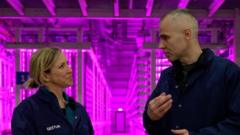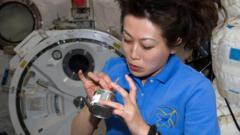Vaxa Technologies, situated near Iceland’s largest geothermal power plant, is pushing the boundaries of food production through its unique indoor farm specifically designed for cultivating microalgae. Under an unusual pink-purple hue emanating from overhead panels, this high-tech facility represents a remarkable step forward in sustainable farming.
General Manager Kristinn Haflidason showcases the farm's operations, emphasizing the growing awareness around microalgae as a viable food resource. Historically overshadowed by macroalgae like seaweed, microalgae have been consumed since ancient times in various regions around the globe, but are now gaining recognition for their nutritional value and sustainability traits.
The Vaxa facility, located approximately 35 minutes from Reykjavik, specializes in the production of Nannochloropsis, a microalgae variety that serves both as human food and as feed for aquaculture. The operation also cultivates Arthospira, commonly known as spirulina, renowned for its health benefits and culinary uses.
One of the plant's distinguishing features is its connection to the geothermal power station, which provides not only clean electricity but also essential resources like cold water for cultivation, hot water for temperature control, and recycled CO2 emissions—components that together create a remarkably carbon-negative operation.
Food technology consultant Asger Munch Smidt-Jensen notes that Vaxa’s setup possesses both a low footprint regarding land and water usage, complemented by the significant energy efficiency thanks to renewable geothermal resources. This integration exemplifies how regions with low-impact energy supplies can effectively produce energy-intensive products.
Inside Vaxa, I observe modular systems known as photo-bioreactors, where LED lights replicate sunlight to stimulate extensive microalgae growth. Controlled conditions and machine learning optimize these systems, enabling the farm to harvest about 7% of its crop daily, with a capacity reaching up to 150 metric tonnes annually. Such advancements could potentially contribute significantly to alleviating global food insecurity, as microalgae boast high levels of protein, carbohydrates, omega-3 fatty acids, and vitamins.
Industry experts predict that the demand for microalgae is on the rise, with market projections estimating a worth of $25.4 billion by 2033. Various companies, such as Danish startup Algiecel, are experimenting with portable bioreactor modules intended for areas near carbon emissions to convert CO2 into usable food.
Despite the promising prospects, challenges remain in making microalgae a staple in diets. Texture and flavor, particularly from saltwater varieties, can be deterrents, but researchers like Malene Lihme Olsen suggest integrating microalgae into familiar foods may address these issues.
Visiting the Vaxa facility, I encounter the harvested microalgae, a green sludge awaiting processing. After initial hesitance, I sample it, finding the taste mild and the texture reminiscent of tofu. Haflidason assures that they aren’t advocating for dining on plain green sludge; instead, the processed product enhances the nutritional profiles of commonplace foods such as bread and smoothies.
In conclusion, while microalgae might not yet occupy a prominent place in culinary culture, Vaxa Technologies showcases an exciting glimpse into the future of food production, where innovative techniques may usher in a new era of sustainable and nutritious food options for all.
General Manager Kristinn Haflidason showcases the farm's operations, emphasizing the growing awareness around microalgae as a viable food resource. Historically overshadowed by macroalgae like seaweed, microalgae have been consumed since ancient times in various regions around the globe, but are now gaining recognition for their nutritional value and sustainability traits.
The Vaxa facility, located approximately 35 minutes from Reykjavik, specializes in the production of Nannochloropsis, a microalgae variety that serves both as human food and as feed for aquaculture. The operation also cultivates Arthospira, commonly known as spirulina, renowned for its health benefits and culinary uses.
One of the plant's distinguishing features is its connection to the geothermal power station, which provides not only clean electricity but also essential resources like cold water for cultivation, hot water for temperature control, and recycled CO2 emissions—components that together create a remarkably carbon-negative operation.
Food technology consultant Asger Munch Smidt-Jensen notes that Vaxa’s setup possesses both a low footprint regarding land and water usage, complemented by the significant energy efficiency thanks to renewable geothermal resources. This integration exemplifies how regions with low-impact energy supplies can effectively produce energy-intensive products.
Inside Vaxa, I observe modular systems known as photo-bioreactors, where LED lights replicate sunlight to stimulate extensive microalgae growth. Controlled conditions and machine learning optimize these systems, enabling the farm to harvest about 7% of its crop daily, with a capacity reaching up to 150 metric tonnes annually. Such advancements could potentially contribute significantly to alleviating global food insecurity, as microalgae boast high levels of protein, carbohydrates, omega-3 fatty acids, and vitamins.
Industry experts predict that the demand for microalgae is on the rise, with market projections estimating a worth of $25.4 billion by 2033. Various companies, such as Danish startup Algiecel, are experimenting with portable bioreactor modules intended for areas near carbon emissions to convert CO2 into usable food.
Despite the promising prospects, challenges remain in making microalgae a staple in diets. Texture and flavor, particularly from saltwater varieties, can be deterrents, but researchers like Malene Lihme Olsen suggest integrating microalgae into familiar foods may address these issues.
Visiting the Vaxa facility, I encounter the harvested microalgae, a green sludge awaiting processing. After initial hesitance, I sample it, finding the taste mild and the texture reminiscent of tofu. Haflidason assures that they aren’t advocating for dining on plain green sludge; instead, the processed product enhances the nutritional profiles of commonplace foods such as bread and smoothies.
In conclusion, while microalgae might not yet occupy a prominent place in culinary culture, Vaxa Technologies showcases an exciting glimpse into the future of food production, where innovative techniques may usher in a new era of sustainable and nutritious food options for all.






















